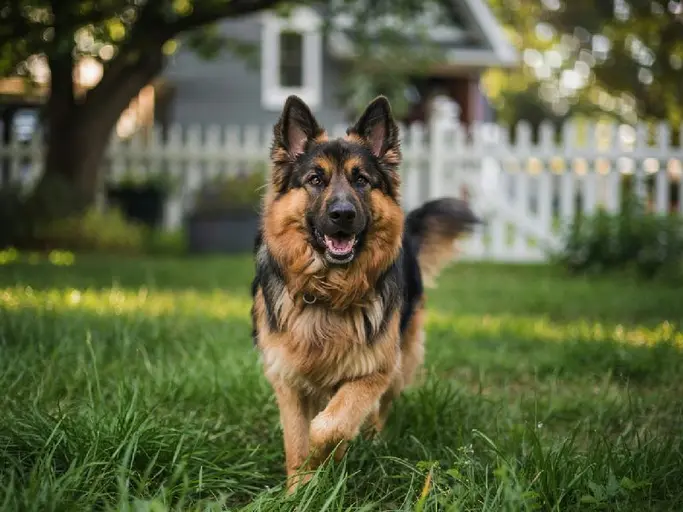The Ultimate Guide to the German Shepherd Dog: Is This the Breed for You?

Brief Introduction
The German Shepherd Dog, often simply called a GSD, is one of the most popular and recognizable dog breeds in the world. Renowned for their intelligence, loyalty, and protective nature, German Shepherds excel in a wide range of roles, from family companions to police and military work. Their striking appearance, characterized by their noble bearing and athletic build, further contributes to their widespread appeal. What makes them so attractive? A combination of brains, brawn, and unwavering devotion. They are a breed that demands respect and provides it in return. This comprehensive guide will delve into the history, appearance, character, care, and potential challenges associated with owning a German Shepherd, offering valuable insights for prospective owners.
Breed History
The German Shepherd’s history is relatively recent, dating back to the late 19th century. The breed was systematically developed in Germany by Max von Stephanitz, a cavalry officer who aimed to create the perfect herding dog.
Early Development
Stephanitz, often referred to as the “father of the German Shepherd,” believed in breeding for working ability rather than simply appearance. He traveled throughout Germany, selecting dogs with the desired traits: intelligence, stamina, courage, and a gentle nature towards livestock. In 1899, he acquired a dog named Horand von Grafrath, considered the first German Shepherd. Horand became the cornerstone of the breed, and Stephanitz founded the Verein für Deutsche Schäferhunde (SV), the German Shepherd Dog Club, to standardize and promote the breed.
Role in the Past
Initially, German Shepherds were primarily used for herding sheep, hence the name “Schäferhunde” (shepherd dogs in German). However, Stephanitz envisioned a broader utility for the breed. With the decline of traditional shepherding, he recognized the potential for German Shepherds to excel in other roles, such as police work, military service, and as guide dogs for the blind. During World War I, German Shepherds served with distinction in the German army, proving their versatility and bravery. This cemented their reputation as a capable and reliable working breed.
Breed Formation
The German Shepherd breed was formed through careful selection and controlled breeding. Stephanitz enforced strict standards for temperament and working ability. He also emphasized the importance of maintaining the breed’s health and soundness. The SV maintained meticulous records of pedigrees and held conformation shows to ensure the breed maintained its desired characteristics. This disciplined approach to breeding helped to establish the German Shepherd as a distinct and consistent breed, renowned for its working ability and unwavering character. The breed quickly gained popularity across the globe in the early 20th century.
Appearance
German Shepherds are medium to large-sized dogs with a distinctive and athletic build. Their appearance reflects their working heritage, combining strength, agility, and a noble presence.
Height and Weight
- Males typically stand 24 to 26 inches (60 to 65 cm) tall at the withers.
- Females are slightly smaller, standing 22 to 24 inches (55 to 60 cm) tall.
- Weight for males ranges from 65 to 90 pounds (30 to 40 kg).
- Females typically weigh between 50 and 70 pounds (22 to 32 kg).
Coat
The German Shepherd’s coat is a double coat, consisting of a dense outer coat and a soft undercoat. This provides insulation in both hot and cold weather. The outer coat is typically medium-length and straight or slightly wavy.
Color
The most common color combination is black and tan (or black and red), but German Shepherds can come in a variety of colors, including:
- Black
- Sable (agouti)
- White (considered a fault in some breed standards)
- Blue
- Liver
Ears
German Shepherds have medium-sized, erect ears that are wide at the base and pointed at the tips. They are carried forward when the dog is alert and attentive.
Eyes
Their eyes are medium-sized, almond-shaped, and typically dark brown. A bright and intelligent expression is characteristic of the breed.
Tail
The tail is bushy and reaches at least to the hock joint. It is carried in a slight curve when the dog is relaxed. When the dog is excited or alert, the tail may be raised higher, but it should never curl over the back.
Other Characteristic Features
- Strong, muscular build
- Proportioned & balanced physique
- A distinctive “gait,” or way of moving
- Noble and intelligent expression
Character and Behavior
The German Shepherd’s character is a hallmark of the breed. They are known for their intelligence, loyalty, and protective nature. However, responsible breeding and proper training are essential to ensure these traits manifest in a positive way.
Attitude Towards People
German Shepherds are generally loyal and devoted to their families. They can be reserved or aloof with strangers, but they should never be aggressive without provocation. Early socialization is crucial to ensure they are comfortable and well-behaved in various social situations.
Attitude Towards Children
With proper socialization and training, German Shepherds can be excellent family dogs and gentle companions for children. However, it’s important to teach children how to interact respectfully with dogs and to supervise interactions, especially with young children. German Shepherds, despite their size, can be very patient & good family dogs.
Attitude Towards Animals
German Shepherds can be territorial and may display aggression towards other dogs, especially those of the same sex. Early socialization with other animals is crucial to minimize these tendencies. With proper training and management, they can coexist peacefully with other pets, but supervision is always recommended.
Activity Level
German Shepherds are high-energy dogs that require a significant amount of exercise to stay happy and healthy. They need daily walks, runs, or other activities to burn off excess energy. Mental stimulation is also important, so provide them with opportunities to learn new things and challenge their minds.
Trainability
German Shepherds are highly intelligent and eager to please, making them relatively easy to train. They excel in obedience training, agility, and other dog sports. Positive reinforcement techniques are most effective. They need a firm but fair owner.
Breed Characteristics
- Highly intelligent
- Loyal and devoted
- Protective and territorial
- High-energy
- Trainable
Care and Maintenance
Proper care and maintenance are essential to ensure the health and well-being of a German Shepherd. This includes regular grooming, exercise, feeding, and veterinary care.
Care Features
German Shepherds require regular grooming to maintain their coat. Brushing them several times a week will help to remove loose hair and prevent matting. During shedding season (spring and fall), daily brushing may be necessary.
Exercise
As mentioned earlier, German Shepherds are high-energy dogs and need a significant amount of exercise. Aim for at least an hour of exercise per day, which can include walks, runs, hikes, or playing fetch.
Feeding
Feed your German Shepherd a high-quality dog food that is appropriate for their age, activity level, and overall health. Follow the feeding guidelines provided by the manufacturer and adjust the amount as needed to maintain a healthy weight.
Grooming
German Shepherds have a double coat that requires regular maintenance. They benefit from:
- Regular brushing, especially during shedding season.
- Occasional bathing when needed (every few months).
- Nail trimming every few weeks
- Regular ear cleaning
- Dental care
A haircut is usually not needed unless specifically instructed by a veterinarian for medical reasons.
Health
German Shepherds are prone to certain health problems, including hip dysplasia, elbow dysplasia, bloat (gastric dilatation-volvulus), degenerative myelopathy, and certain types of cancer. Regular veterinary check-ups and preventative care can help to detect and manage these potential health issues. Buying from a reputable breeder who tests for these conditions is key.
Possible Problems
Potential health problems in German Shepherds include:
- Hip and elbow dysplasia
- Bloat
- Degenerative myelopathy
- Pancreatic insufficiency
- Allergies
Breed Weaknesses
While German Shepherds possess many desirable qualities, it’s important to be aware of their potential weaknesses.
Level of Aggression
German Shepherds can be prone to aggression if not properly socialized and trained. Their protective instincts can sometimes lead to overprotective behavior, especially towards strangers or other animals. Responsible ownership, including early socialization and consistent training, is crucial to prevent aggression.
Loyalty
While loyalty is generally considered a positive trait, excessive loyalty can sometimes lead to possessiveness or guarding behavior. Proper training and socialization can help to mitigate these tendencies.
Specific Weaknesses
- Prone to certain health problems (as mentioned above)
- Can be prone to anxiety if not properly exercised and mentally stimulated
- May exhibit destructive behavior if bored or left alone for long periods
Conclusion
The German Shepherd Dog is a remarkable breed known for its intelligence, loyalty, and versatility. They excel as family companions, working dogs, and protectors. However, they are not the right breed for everyone. They require a dedicated owner who is willing to provide them with the necessary training, exercise, and mental stimulation. If you are prepared to meet their needs, a German Shepherd can be a rewarding and loyal companion for many years to come. Therefore, this breed is suitable for individuals who:
- Are active and can provide ample exercise
- Are experienced dog owners or willing to learn
- Can provide consistent training and socialization
- Are looking for a loyal and protective companion
Ultimately, responsible ownership is key to ensuring a happy and healthy life for both you and your German Shepherd.
Frequently Asked Questions About German Shepherd Dog
-
What are German Shepherds known for?
German Shepherds are renowned for their intelligence, loyalty, and protective nature. They excel in various roles, from family companions to police and military work.
-
How much exercise do German Shepherds need?
German Shepherds are high-energy dogs that require a significant amount of exercise. Aim for at least an hour of exercise per day, including walks, runs, hikes, or playing fetch.
-
Are German Shepherds good with children?
With proper socialization and training, German Shepherds can be excellent family dogs and gentle companions for children. Supervise interactions, especially with young children.
-
What is the average weight of a female German Shepherd?
Females typically weigh between 50 and 70 pounds (22 to 32 kg).
-
What health problems are German Shepherds prone to?
German Shepherds are prone to certain health problems, including hip dysplasia, elbow dysplasia, bloat, degenerative myelopathy, and certain types of cancer.
-
How often should I groom my German Shepherd?
German Shepherds require regular grooming to maintain their coat. Brushing them several times a week will help to remove loose hair and prevent matting. Daily brushing may be necessary during shedding season.
-
Are German Shepherds easy to train?
German Shepherds are highly intelligent and eager to please, making them relatively easy to train. Positive reinforcement techniques are most effective.
-
What colors do German Shepherds come in?
The most common color combination is black and tan (or black and red), but German Shepherds can come in a variety of colors, including black, sable, white, blue, and liver.
-
Are German Shepherds aggressive?
German Shepherds can be prone to aggression if not properly socialized and trained. Responsible ownership, including early socialization and consistent training, is crucial to prevent aggression.
-
What qualities make a German Shepherd a good family dog?
German Shepherds are loyal, protective, and intelligent, making them excellent family dogs with proper training and socialization. They are also known for being patient with children.

